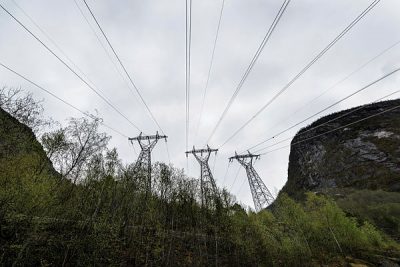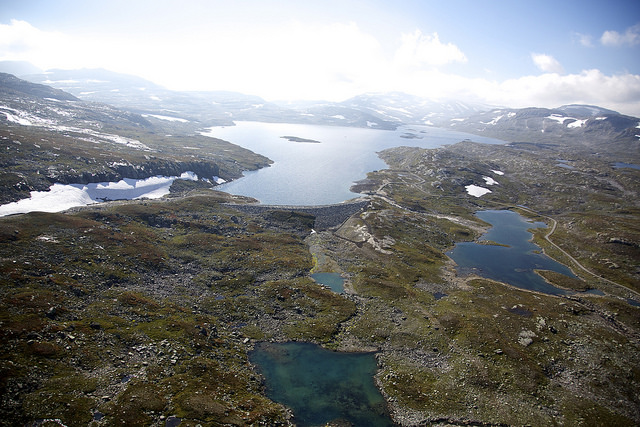Electricity rates set a new summertime record in southwestern Norway on Monday, with consumers having to pay just over NOK 3 per kilowatt hour (kWt) in Rogaland, Agder, Telemark and Vestfold. Water levels in the reservoirs providing hydroelectric power to the region are very low for this time of year, raising concerns that electricity may need to be rationed this winter.

“We’re following the power situation closely,” Oil & Energy Minister Terje Aasland told newspaper Dagens Næringsliv (DN), adding that the government “can’t rule out” a need for measures to restrict electricity consumption. They could include limiting the amounts of water that can be used to produce power (which could trigger rationing), restricting export of electricity, or a combination of both.
He stressed that energy markets are facing great uncertainty all over Europe. Norway, which has been a major producer of hydroelectric power long before it also could export oil and gas, has never seen rates so high in the summer season, when electricity use is traditionally low.
Both the government and power producers are under political pressure to bring down the high electricity rates and avoid rationing this winter. The government’s own Center Party wants to halt all exports of electricity and order electricity companies to conserve the water in their reservoirs. Local mayors are also clamouring for relief, while the Socialist Left Party (SV) is considering a call to reopen Parliament to debate relief measures.
“The situation is now very serious,” Lars Haltbrekken, a Member of Parliament for SV, told state broadcaster NRK during the weekend. “We expect the goverment to do what it can to avoid electricity rationing this winter. If we have to do that, it will affect industry, jobs and folks’ everyday life. It’s not acceptable.”
He and others are proposing demands to maintain higher water levels in reservoirs, renegotiation of Norway’s current export agreements with Great Britain and Germany, higher state compensation for high electricity bills and a long list of measures to improve electricity efficiency in Norway. Because electricity was always one of the few things that was much cheaper in Norway than elsewhere, consumers are not well-trained in cutting electricity consumption themselves. Aasland continues to claim that actual rationing is unlikely, but stresses that it’s an option.
Anders Gaudestad, in charge of electricity management for power producer Agder Energi, confirmed that all of its reservoirs are currently at around two-thirds of normal water levels for this time of year and his company is producing less power because of it. “We could have been even more careful and produced less power last autumn, winter and spring, or been cynical and produced more,” he told DN, “but it wasn’t easy to predict the driest spring in 140 years and that we’d also get a war in Europe.”
Gaudestad stresses that there are many reasons for the record high electricity rates even now in summer, when reservoirs are normally bursting from snow melt and the spring run-off. Now there’s hardly any snow left in the mountains to feed them, at a time when Europe needs Norwegian power more than ever, as an alternative to Russian gas.
Agder Energi and other power companies around Norway have been under criticism and suspicion of trying to maximize profits. Norway’s largest trade union federation LO joined politicians last week in demanding more “social responsibility” from the power producers and ordering them to make sure there’s enough water left in the reservoirs to get through the winter. They note that while they’re sinking to record low levels, Norway has also set new records in electricity exports. At the risk of showing a lack of solidarity with the Ukraine and the need to offer an alternative to Russian gas, LO wants the Labour-Center government to demand that state energy regulator NVE and power agency Statkraft secure water levels in reservoirs.

The challenge then, however, is what would happen if rain starts pouring this fall and there’s not enough capacity in the reservoirs to contain it. The current situation is also most extreme in Southern Norway. Northern Norway has had plenty of rain and snow and its electricity rates are much lower than in the south.
The power industry and companies like Agder Energi have also reacted to all the calls to better save water and restrict exports. They maintain that they’re best at managing power resources: “The power companies are acutely aware there may be a tight power situation this winter,” the director of their professional organization Energi Norge, Eivind Heløe, told newspaper Aftenposten on Saturday. No one is well served, he claims, by saving so much water now that it may spill over and be sent out to sea later.
“We have also produced around 20 percent less power than normal this year, so it’s wrong for anyone to say that we’re only trying to maximize profits for our owners,” Gaudestad at Agder Energi told DN. “We are very conscious of the social responsibility we have as managers of critical infrastructure.”
If precipitation returns to normal this fall and winter, there won’t be an energy emergency, according to NVE. “But we see in our analyses based on 60 years of weather data that if we have a dry summer and fall, followed by a cold and dry winter, there is a risk that it can become critical,” NVE wrote in a report last week. That’s because reservoir levels haven’t been as low as they are now since 1996.
State power distributor Statnett has predicted a 5- to 20 percent chance of electricity rationing this winter. “That means there’s much greater probability that it won’t be necessary to ration electricity,” Statnett wrote in its latest report, “but we’re taking responsibility and releasing water in our waterways (which feed the reservoirs) at the lowest levels to save water.”
newsinenglish.no/Nina Berglund

